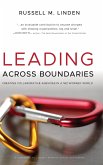In today's dynamic world, technology and innovation are of extreme importance for many organizations and for the advancement of society as a whole. In the past decades, firms have faced grand challenges of fast-changing innovation environments, shortening product life cycles and increased global competition. Especially those firms that seek to establish and maintain a competitive advantage by following an innovation-related strategy have been pressured to ensure an effective and efficient innovation process. However, a centralized R&D configuration with one large in-house domestic location was in many ways no longer sufficient in achieving this. Instead, firms have increasingly crossed country boundaries, have opened up their organizational boundaries, or have done so simultaneously. While there are first insights on the performance implications of crossing country and organizational boundaries, further research is needed to understand better how firms can effectively manage boundary-crossing activities. This is where this thesis sets in. Despite the heterogeneity in methods and specific research questions, all thesis chapters focus on the related general question: How can firms increase their innovation performance through boundary-crossing activities? The thesis implies that through strategically opening up the R&D system and crossing organizational and country boundaries, firms can build and maintain a competitive advantage. However, managers need to assess whether their firm is especially vulnerable to potential downsides of crossing boundaries. Based on this thesis, the assessment can build on three major aspects: First, the specific characteristics of the firm. Second, its management practices. And third, the potential effects on the firm's employees.
Hinweis: Dieser Artikel kann nur an eine deutsche Lieferadresse ausgeliefert werden.
Hinweis: Dieser Artikel kann nur an eine deutsche Lieferadresse ausgeliefert werden.








